| Local data you can use: Trees, health care and work loss |
 |
| News |
| Written by Christy Eull |
| Tuesday, October 10, 2017 06:00 AM |
|
For example, researchers estimated that in Denver, planting and maintaining trees for public health could avoid as much as $192,000 in costs related to health care and work loss. In a separate study cited by TNC, the return on investment in urban forest management in Fort Collins is $2.18 for every dollar spent. “As city populations grow, urban trees cannot be viewed as a luxury: Trees are an essential component of a livable community and a core strategy for improving public health,” notes the study. But most cities in the US are losing trees each year—a decline of about 1.3%. Trees are being lost not just from the natural life cycle, but from development. Working with government and developers to increase the number of trees planted could produce significant benefits to the mental and physical health of residents. Experts estimate that investing just $8 per resident each year in tree planting could produce significant results in improved air quality and health outcomes. Recommendations in the report include policy guidance for municipalities and legislators. Read the full report here. Editor’s note: These findings are consistent with those of the CSU research team documented in "The Hidden Value of Landscapes," released earlier this year. Given the anticipated losses in Colorado from Emerald Ash Borer alone, these findings offer the industry data we can use to promote sustainable landscape practices, especially tree planting. Read more in this issue of Colorado Green NOW: |

 A September report by The Nature Conservancy (TNC), in collaboration with Analysis Group and Trust for Public Land, makes the case for including trees as part of a city’s public health plan. The report, titled “Funding Trees for Health,” demonstrates that there is a connection between urban trees and public health. By connecting the two financially and investing in the urban canopy, cities may create a cost saving in health care and work loss.
A September report by The Nature Conservancy (TNC), in collaboration with Analysis Group and Trust for Public Land, makes the case for including trees as part of a city’s public health plan. The report, titled “Funding Trees for Health,” demonstrates that there is a connection between urban trees and public health. By connecting the two financially and investing in the urban canopy, cities may create a cost saving in health care and work loss.